Archive for March, 2016
From the collection: a Fauvist’s Design!
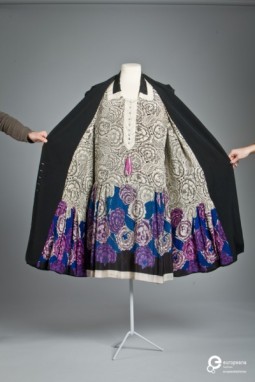
Belonging to Modemuseum Hasselt’s beautiful collection, these dress and coat designed by Zimmermann are a beautiful example of the way art and fashion contaminate their worlds.
A contemporary of Zimmermann, Paul Poiret wrote in his memoirs “Am I a fool when I dream of putting art in my dresses, a fool when I say dressmaking is an art?”. Indeed, in this ensemble, Zimmermann put the art of the Fauvist painter Raoul Dufy (1877-1953), who designed the floral fabric of which are made the dress and the jacket’s lining.

The ensemble designed by Zimmermann, made of the fabric designed by Raoul Dufy for Bianchini-Férier. Collection Modemuseum Hasselt, all rights reserved.
Raoul Dufy designed this silk fabric for the textile company Bianchini-Férier in Lyon, who collaborated with a long list of great fashion Houses and designers, like Worth, Poiret, Vionnet, Lanvin, but also Dior, Yves Saint Laurent, Jean Paul Gaultier, Hussein Chalayan, Dries van Noten. Dufy signed a contract with the company in 1912 and for them produced no less than four thousands designs until 1928.

The ensemble designed by Zimmermann, made of the fabric designed by Raoul Dufy for Bianchini-Férier. Collection Modemuseum Hasselt, all rights reserved.
The French fashion House Zimmermann, set in 10 Rue des Pyramides, was therefore not the only which created garments with Dufy’s fabrics. Among the many designs created with these textiles, in The Kyoto Costume Institute collection there is a dress designed by Zimmermann in 1922 with the same fabric, but in a different colour!
Browse the incredible collection of Modemuseum Hasselt and find other beautiful fabrics by Bianchini-Férier!
“HAIR! In Fashion and Art” at Centraal Museum

Human hair is a quite wide subject in fashion and art, which has never been the subject of a comprehensive research. Centraal Museum focused on the theme in its new exhibition, “HAIR! Human Hair in Fashion and Art”!
On show through the 29th May, “HAIR! Human Hair in Fashion and Art” provides an insight on the topic by exploring its historical and contemporary aspects, as a result of a cultural-historical research conducted by Centraal Museum. There are many examples of human hair in fashion, Alexander McQueen used to put a lock of his hair in its creations, and Walter van Beirendonck printed a trompe l’oeil bare man’s top on a t-shirt.

Walter Van Beirendonck for Wild & Lethal Trash (W.& L.T.), tee-shirt printed with a trompe l'oeil bare man's top, 1996-1997. Collection Les Arts Décoratifs, all rights reserved.
Hair is a symbol with many meanings, not only related to body and sex, but also to history, religion and mythology. Facial and body hair then are subject to fashion themselves. The exhibition will display the work of many contemporary visual artists and international fashion designers who have been inspired by this material, such as Charlie Le Mindu, Julien d’Ys, Christiaan Houtenbos, Zoran Todorovic, Bob Recine and Silvia B.

Photo: “Babe”, rubber, human hair, pigment, Zhu Tian, 2013. “HAIR! Human Hair in Fashion and Art”, Centraal Museum, all rights reserved.
Moreover, because of the exhibition “HAIR!”, the Textile Symposium will be held on the 14th of April 2016, at Centraal Museum. The main subject of the symposium is how human hair is used as a textile. You can find more information about the symposium on the website of the Textile Commission.
For more information about the exhibition, visit Centraal Museum. Browse Centraal Museum amazing collection on Europeana Fashion!
“Game Changers. Reinventing the 20th Century Silhouette”
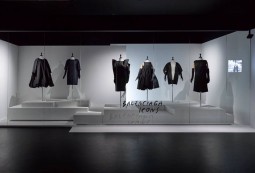
Through the 2oth century, the female silhouette changed radically many times in fashion over the influence of legendary createurs and designers. MoMu celebrates these innovators with its new exhibition, “Game Changers. Reinventing the 20th Century Silhouette”!
Focusing on the figure of Cristóbal Balenciaga, the master couturier, the MoMu – Fashion Museum Antwerp’s exhibition offers the occasion to reflect about fashion as a medium to design the body, exploring its architecture and volumes through the work of the many ground-breaking designers who, like Balenciaga, revolutionized the female silhouette over the 20th century.

The exhibition "Game Changers – Reinventing the 20th century silhouette" at MoMu - Fashion Museum Antwerp. Photo: © MoMu Antwerp/ Stany Dederen
The female silhouette has always been shaped by fashion in many astounding and sometimes bizarre ways. It was only in the 20th century, however, that again a certain freedom was given to women by the couturiers like Poiret, Vionnet and Chanel who abandoned the corsets, introducing soft and less constrictive lines. During that last century, designers experimented with increasing freedom and their results changed the rules of the game of fashion.
The exhibition therefore brings together one hundred years of fashion history, showing – alongside the breath-taking creations and the patterns of Balenciaga – pieces designed by Paul Poiret, Madeleine Vionnet and Coco Chanel, but also the iconic work of more contemporary designers, like the lumpy outfits of Comme des Garçons “Body meets Dress, Dress meets Body” S/S 1997 collection, Issey Miyake pleated designs and Maison Martin Margiela’s highly conceptual garments, including pieces by Ann Demeulemeester and Yohji Yamamoto.
The exhibition will be on show through the 14th August 2016. For more information, please visit MoMu – Modemuseum Provincie Antwerpen. Browse also MoMu’s amazing digitalized collection on Europeana Fashion portal!
A Cena da Krizia

A group of friends remembers the Italian fashion designer Krizia with an intellectual dinner at the famous Spazio Krizia in Manin street, Milano.
Passed away last December, Mariuccia Mandelli – she took the name Krizia after Plato’s dialogue on Vanity – was one of the greatest Italian designers, who achieved many successes during her long career in fashion. Her debut took place in 1957 at the SAMIA fair in Turin where she showed an ante-litteram minimalist style that impressed public, buyers and press. During the Sixties she presented her creations at Sala Bianca at Palazzo Pitti and was the first woman to get the prize “Critica della Moda” in 1964 – a prize only assigned before to Emilio Pucci – but was among the first designers to choose Milan as the new fashion scene in the early Seventies. In 1982 she was invited by the Cambridge’s MIT to show her creations at the exhibition “Intimate Architecture: Contemporary Clothing Design” along with Gianfranco Ferré and Issey Miyake, among others.

An ensemble designed by Krizia, exhibited in “La Sala Bianca: La Nascita della Moda Italia”, at Pitti Uomo 42, 1992. Collection Pitti Immagine, all rights reserved.
In 1984 she opened her headquarters, in the totally renovated Palazzo Melzi d’Eril in Milan that comprehended Spazio Krizia, a place designed to host cultural activities, such as shows, exhibitions, concerts. A place, to “do fashion speaking about other things”. For more than 20 years, Spazio Krizia has been the one of epicentre of Milanese culture: the mood and important legacy of this place and of the group of intellectuals that gathered around Krizia, is re-invoked in the video “A Cena da Krizia” directed by Tomaso Pessina.

Knitted jumper with animal motif, designed by Krizia, ca. 1985, Italy. © Krizia. Collection Victoria and Albert Museum, CC-BY-NC.
The same Spazio Krizia is a witness of a renewed multidisciplinary approach: the dinner, brings back together old and new protagonist of the Milanese cultural and fashion scene. Beppe Modenese, Mariuccia Casadio, Gillo Dorfles together with Angelo Flaccavento, Antonio Mancinelli, Carlo Capasa share their memories on the Italian designer, retracing the brand’s DNA, hosted by Zhu ChongYun, the Chinese fashion designer and entrepreneur who acquired the brand Krizia.
The video “A Cena da Krizia” can be watched on Youtube.To have a look at Krizia creations, browse Europeana Fashion portal!
Designers’ Signature Flowers
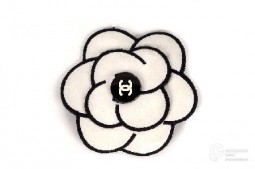
This March, Europeana Fashion is exploring the use of flowers through fashion history, curating Europeana Fashion Tumblr with a selection of pictures from its partners’ collections.
There are many designers in fashion that are recognized for their charachteristic use of flowers in their creations. The flowers these designers include in their creations are often associated with many meanings, drawn from history, popular culture and art. However, sometimes the game changes and some particular flowers becomes heralds of the designers’ styles and aesthetics.

Fashon Designs by Paul Poiret, 1908. illustrated by Paul Iribe. Les Robes de Paul Poiret, p.17. Source: Internet Archive. Wikimedia Commons, public domain.
The stylized rose which was featured in many of Paul Poiret pieces is one of the earliest examples of fashion’s signature flowers. It was designed by the illustrious fashion illustrator Paul Iribe and it became, for its unicity, an emblem of Poiret’s style.
The two most notable instances are however Christian Dior’s lily of the valley, the couturier’s favourite flower, and Coco Chanel’s camellias. Both the creators used to have their flowers pinned in their lapels or adorning their personal stationery and effects. They also used them in their collections. Dior dedicated to the lily of the valley his 1954 collection, while Coco Chanel used cammellias as a recurrent detail in his clothes, may it the be a pin, a button or an application.

Camellia shaped pin, part of Chanel Fall-Winter 1990-91 collection. Photo Museo del Traje, all rights reserved.
These flowers, a signature of the designers’ style, become therefore a code and an emblem that still defines these Houses aesthetics. Visit our Tumblr to find more examples of the designers’ use of flowers or browse Europeana Fashion’s collection!
Europeana Fashion invites you to a Garden Party!
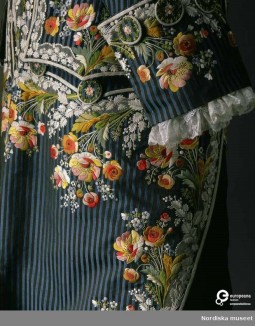
Stay connected to Europeana Fashion Tumblr through all this March to find everyday a flower-inspired picture from Europeana Fashion collection!
Highlighting the most beautiful objects selected from our partner’s collections, with this curation Europeana Fashion will explore the different use of flowers in fashion, as decoration, inspiration or even as pattern for fabulous sculpted gowns and dresses.

Cocktail dress in silk organdy designed by Jean Dessès, 1950-1955 ca. Collection Les Arts Décoratifs, all rights reserved.
Flowers in fashion evolved not only in their form, but also in their meaning. In the 15th century floral fabrics were considered in Europe a synonym of superiority and social prestige, since only few could afford buying the delicately ornate fabrics imported by the traders. In the last decades of the 20th century, however, flowers and other natural elements started to be associated with equality and acceptation.

Detail of a men’s attire with coat and waistcoat in embroidered silk, made in France around 1785. Photo by Mats Landin. Collection Nordiska museet, CC-BY-NC-ND.
Floral decorations never lose their fascination and appeal on designers, who still involve them in their creations challenging the way they could be featured in fashion.
Immerse yourself in this garden of digital delights and browse our portal to find more!
Introducing two new Europeana Fashion Supporting Members!
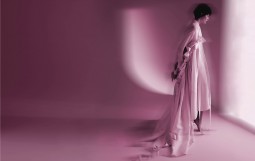
We’re happy to announce that two additional prestigious fashion institutions joined our Europeana Fashion International Association: the Milan based Gianfranco Ferré Foundation and MUDE (Museu do Design e da Moda) from Lisbon.

GIANFRANCO FERRÉ | ARTISTA| F/W 1993. Gianfranco Ferré. Photo: Leonardo Salvini. Exhibition: La Camicia Bianca Seconde Me - Gianfranco Ferré.
The Gianfranco Ferré Foundation was established in February 2008, primarily with the aim of preserving, organizing and making available to the public – first and foremost in digital archive form – the patrimony of materials that document the designer’s professional activity. It also has the goal of promoting, pursuing and carrying out projects that relate to the Gianfranco Ferré philosophy and culture of design, to the maestro’s unique idea of fashion and exquisite aesthetic sensitivity.
The Gianfranco Ferré Foundation will make available online through Europeana Fashion some of the best pieces of its archive. In the meantime you can have a look at Gianfranco Ferré Foundation’s curation “La Camicia Bianca Seconde Me. Gianfranco Ferré” on Europeana Fashion Tumblr.
MUDE, Lisbon Design and Fashion Museum, is one of the original content provider of the Europeana Fashion project and many of its amazing items are already accessible through our portal.
The MUDE Collection results of the Francisco Capelo’s work and dedication, started in the 1990s. With more than 1,200 design and 1,500 fashion pieces, most of it haute couture, Francisco Capelo Collection portrays the history of design and fashion from the 1930s to the present, being an exceptional collection to Portugal and to the international scene. Design and fashion were assembled in a complementary manner, with each piece chosen through a concept-based museum dialogue, and not according to personal tastes.
Enjoy MUDE digital collections on the Europena Fashion portal!
“Lettres à un jeune couturier” from Gianfranco Ferré
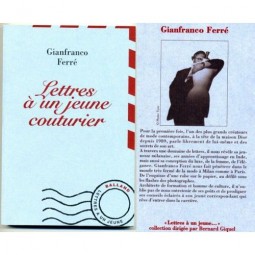
Published in Paris in 1995 by Balland, “Lettres à un jeune Couturier” is an epistolary novel written by Gianfranco Ferré when he was Art Director at Christian Dior.
The story talks about Ferré, the famous and accomplished designer, who engages a correspondence with Federico, an Italian guy who means to become a designer as well. In his answers, Ferré gives to him informations and recommendetions about the most relevant facts about the fashion world. Curated by Frank Maubert, the book also disclose curiosity, passions and experiences of Ferrè’s life.
The Ferré foundation has recently decided to edit a new Italian translation of this opera, originally published in French.. To receive a PDF copy of the book, please send an email to info@fondazioneferre.com
Gianfranco Ferré has always been interested in youth education. He dedicated part of his life to teaching until his old age. In 2009 Marsilio Editori has published most of his lectures in the book “Gianfranco Ferré. Lezioni di moda”, curated by Maria Luisa Frisa.





